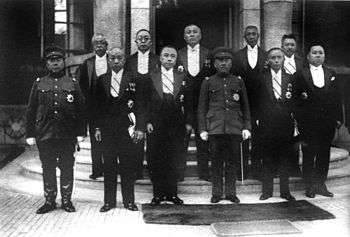General Affairs State Council
The General Affairs State Council (国務院) was the de facto executive administrative branch of the government of the Japanese-controlled Empire of Manchukuo from 1934–1945.

Background
Manchukuo was proclaimed a monarchy on 1 March 1934, with former Qing dynasty emperor Puyi assuming the Manchukuo throne under the reign name of Emperor Kang-de. An imperial rescript issued the same day, promulgated the organic law of the new state, establishing a Privy Council (参議府), a Legislative Council (立法院) and the General Affairs State Council to "advise and assist the emperor in the discharge of his duties". The Privy Council was an appointive body consisting of Puyi's closest friends and confidants, and the Legislative Council was largely an honorary body without authority. The State Council was therefore the center of political power in Manchukuo.
Workings
The General Affairs State Council consisted of ten ministries forming a cabinet. The cabinet ministers were all native Manchukuoans, of either ethnic Manchu or Han Chinese descent, and in all cases, the vice-ministers in each ministry were Imperial Japanese Army officers, appointed by the Kwantung Army leadership. The Japanese vice-ministers functions in roles similar to British resident officers in British overseas protectorates in that they had final approval over any actions of the "native" ministers. The State Council itself was presided over by a Secretary-General, the first of whom was Takuzo Komai, an ethnic Japanese.
The Council's initial composition was at the time of Prime Minister Zheng Xiaoxu included the following portfolios:

- Prime Minister
- Home Affairs
- Foreign Affairs
- Defense
- Finance
- Industry and Agriculture
- Transportation and Communications
- Justice
- Education
- Mongolian Affairs
The State Council building
The State Council Building was an imposing five-story structure with two four-story wings built in downtown Hsinking in reinforced concrete with a portal frame construction with a pseudo-oriental roof with towers. The building was designed so that its main entrance faces west. The building is still in use today by the Jilin Provincial government of the People's Republic of China. Each of the main cabinet-level ministries also had its own imposing building. Many of these structures are still in use in various capacities in modern China.
References
- Beasley, W.G. (1991). Japanese Imperialism 1894-1945. Oxford University Press. ISBN 0-19-822168-1.
- Dower, John W (1987). War Without Mercy:Race and Power in the Pacific War. Pantheon. ISBN 0-394-75172-8.
- Young, Louise (1999). Japan's Total Empire: Manchuria and the Culture of Wartime Imperialism. University of California Press. ISBN 0-520-21934-1.
- Stoler, Ann Louise (2007). Imperial Formations. School for Advanced Research Press. ISBN 1-930618-73-5.